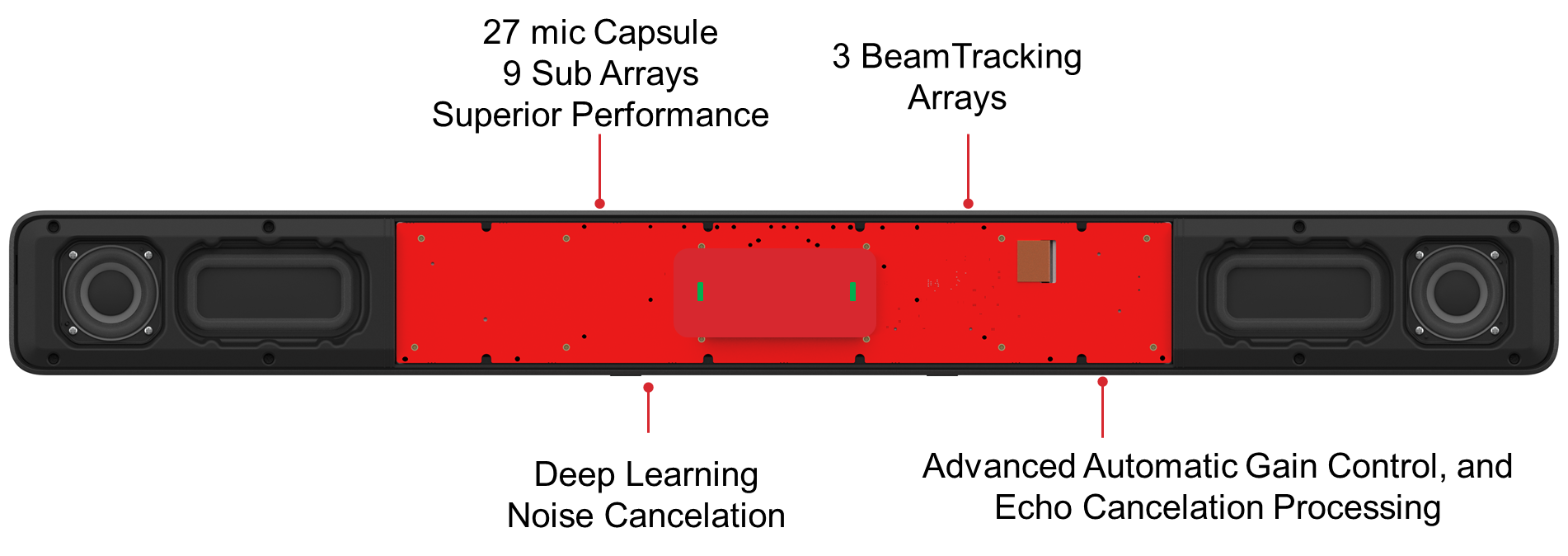Artificial intelligence!

It may seem like more of a buzzword in recent years, but the truth is AI is trending because it's changing the way we work, find information, and collaborate.
Not only is it automating mundane tasks, but it's also being used by companies of all sizes to aid in decision-making, customer service, and product development. The rigorous process of data collection is becoming more streamlined every day, allowing for companies to increase their productivity and accuracy.
As an audio-visual company, we've felt the aftershocks of the AI boom in the audio-video world too. More often we're installing conferencing solutions with AI capabilities like facial and speech recognition. But that's just the tip of the iceberg - here's a much broader scope of what it's improving.
What Are We Seeing Now?
Automatic Framing and Portrait Lighting

Video devices now have the ability to automatically adjust framing and lighting to whoever is speaking. This is a common feature now on many video bars, from the Poly Studio X Series, Huddly IQ, Jabra Panacast 50, Parle VCB2500, and many more devices.
Utilizing facial recognition and machine learning algorithms to track the speaker's movements, the device ensures that they remain visible and centered in the frame as they move around the room. While it might be disorienting if it's only for one person in a small space, this feature is especially useful in large conference rooms with multiple speakers, or remote work settings where attendees may be joining from different locations.
By automating the framing process, it eliminates the need for manual adjustments and provides a seamless experience for all participants. Additionally, it allows for a more engaging and professional presentation, as the audience can stay focused on the speaker.
Beamforming Audio & Noise Cancellation

This technology utilizes multiple microphones and AI algorithms to analyze the acoustics of a room and dynamically adjust the direction and focus of sound waves to specific locations, such as individual speakers or groups of people. By completely removing background noise (such as chair squeaks, coughing, pencil tapping, and even cars) and excessive room echo, it is ensured that everyone in the room can hear and be heard clearly.
With the help of AI, the system can adapt to changing conditions in real-time and provide a seamless experience for all participants, regardless of their location or environment. This technology is becoming increasingly popular in large conference rooms, classrooms, and other spaces where clear and accurate audio is essential.
Natural-Language Processing
Natural-language processing (NLP) is another area where AI is revolutionizing the A/V industry.
NLP is a branch of AI that focuses on the interaction between computers and human language, allowing machines to understand and interpret spoken or written language in a more natural and intuitive way. NLP is being used in a variety of applications in the A/V industry, such as voice recognition, language translation, and transcription services.
For example, voice assistants like Siri, Alexa, and Google Assistant use NLP to understand and respond to natural language requests, making it easier for users to interact with technology. NLP technology is also being used in transcription services to automatically convert spoken language into written text, which can be beneficial for recording and archiving meetings, conferences, or even for participants who are deaf or hard of hearing.
So, What Will We See?
Digital Signage

AI's impact in digital signage is already being noticed by many in the industry, but its use case isn't widespread just yet. There's a few ways we can see digital signage being transformed by AI.
With the help of computer vision and machine learning algorithms, digital signage can track consumers' behavior in response to an advertisement. Additionally, AI-powered digital signage can use facial recognition to measure a consumer's emotional response to an ad, allowing advertisers to understand how their content is being received and make improvements accordingly. This technology has the potential to significantly increase the effectiveness of digital signage as an advertising tool and provide valuable insights into consumer behavior.
Larger A/V Productions
While AI is already making waves in the A/V industry, the future promises even more complex uses in larger media productions.
Using the tools above, automatic systems can be created for bigger productions, such as churches. Like how an automatic switcher works, live broadcasts can filter out the use of a person controlling the video signals for an AI program designed to change angles based on certain factors. And if you've got a camera on a motorized rig, the same application used for auto framing can be seen for live events.

